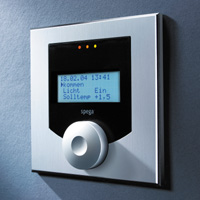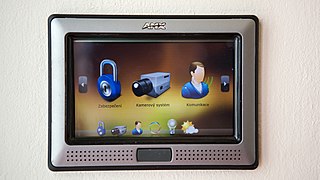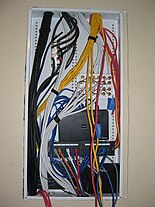
Home automation or domotics is building automation for a home. A home automation system will monitor and/or control home attributes such as lighting, climate, entertainment systems, and appliances. It may also include home security such as access control and alarm systems.
Zigbee is an IEEE 802.15.4-based specification for a suite of high-level communication protocols used to create personal area networks with small, low-power digital radios, such as for home automation, medical device data collection, and other low-power low-bandwidth needs, designed for small scale projects which need wireless connection. Hence, Zigbee is a low-power, low-data-rate, and close proximity wireless ad hoc network.

Z-Wave is a wireless communications protocol used primarily for residential and commercial building automation. It is a mesh network using low-energy radio waves to communicate from device to device, allowing for wireless control of smart home devices, such as smart lights, security systems, thermostats, sensors, smart door locks, and garage door openers. The Z-Wave brand and technology are owned by Silicon Labs. Over 300 companies involved in this technology are gathered within the Z-Wave Alliance.
Building automation (BAS), also known as building management system (BMS) or building energy management system (BEMS), is the automatic centralized control of a building's HVAC, electrical, lighting, shading, access control, security systems, and other interrelated systems. Some objectives of building automation are improved occupant comfort, efficient operation of building systems, reduction in energy consumption, reduced operating and maintaining costs and increased security.

A home network or home area network (HAN) is a type of computer network that facilitates communication among devices within the close vicinity of a home. Devices capable of participating in this network, for example, smart devices such as network printers and handheld mobile computers, often gain enhanced emergent capabilities through their ability to interact. These additional capabilities can be used to increase the quality of life inside the home in a variety of ways, such as automation of repetitive tasks, increased personal productivity, enhanced home security, and easier access to entertainment.

A computer appliance is a computer system with a combination of hardware, software, or firmware that is specifically designed to provide a particular computing resource. Such devices became known as appliances because of the similarity in role or management to a home appliance, which are generally closed and sealed, and are not serviceable by the user or owner. The hardware and software are delivered as an integrated product and may even be pre-configured before delivery to a customer, to provide a turn-key solution for a particular application. Unlike general purpose computers, appliances are generally not designed to allow the customers to change the software and the underlying operating system, or to flexibly reconfigure the hardware.
The Internet of things (IoT) describes devices with sensors, processing ability, software and other technologies that connect and exchange data with other devices and systems over the Internet or other communications networks. The Internet of things encompasses electronics, communication, and computer science engineering. "Internet of things" has been considered a misnomer because devices do not need to be connected to the public internet; they only need to be connected to a network and be individually addressable.
Ember was an American company based in Boston, Massachusetts, USA, which is now owned by Silicon Labs. Ember had a radio development centre in Cambridge, England, and distributors worldwide. It developed Zigbee wireless networking technology that enabled companies involved in energy technologies to help make buildings and homes smarter, consume less energy, and operate more efficiently. The low-power wireless technology can be embedded into a wide variety of devices to be part of a self-organizing mesh network. All Ember products conform to IEEE 802.15.4-2003 standards.
Control4 is a provider of automation and networking systems for homes and businesses, offering a customizable and unified smart home system to automate and control connected devices including lighting, audio, video, climate control, intercom, and security. The Control4 platform interoperates with more than 13,500 third-party products and it is available in over 100 countries. In August 2018, it managed 370,000 homes. The company is based in Salt Lake City, Utah. Control4 was a publicly traded company from 2013 until 2019, when it merged with SnapAV.

Google Nest is a line of smart home products including smart speakers, smart displays, streaming devices, thermostats, smoke detectors, routers and security systems including smart doorbells, cameras and smart locks.

This is a list of home automation topics on Wikipedia. Home automation is the residential extension of building automation. It is automation of the home, housework or household activity. Home automation may include centralized control of lighting, HVAC, appliances, security locks of gates and doors and other systems, to provide improved convenience, comfort, energy efficiency and security.
HomeSeer Technologies LLC is a technology company based in Bedford, New Hampshire, in the United States. HomeSeer makes home automation controllers and software, designed to integrate lighting, HVAC, security, AV and other subsystems in most homes. Additionally, the company maintains an online store of compatible home automation products and a free online community forum for users and dealers.

Wink is an American brand of software and hardware products that connects with and controls smart home devices from a consolidated user interface. Wink, Labs Inc., which develops and markets Wink, was founded in 2014 as a spin-off from invention incubator Quirky. After Quirky went through bankruptcy proceedings, it sold Wink to Flex in 2015. As of 2016, the Wink software is connected to 1.3 million devices. In July 2017, Flex sold Wink to i.am+ for $59 million.
Universal Electronics Inc. (UEI) is an American smart home technology provider and manufacturer of universal remote controls, IoT devices such as voice-enabled smart home hubs, smart thermostats, home sensors; as well as a white label digital assistant platform optimized for smart home applications, and other software and cloud services for device discovery, fingerprinting and interoperability. The company designs, develops, manufactures and ships products both under the "One For All" brand and as an OEM for other companies in the audio video, subscription broadcasting, connected home, tablet and smart phone markets. In 2015, it expanded its product and technology platform to include home automation, intelligent sensing and security.

open Home Automation Bus (openHAB) is an open source home automation software written in Java. It is deployed on premises and connects to devices and services from different vendors. As of 2019, close to 300 bindings are available as OSGi modules. Actions, such as switching on lights, are triggered by rules, voice commands, or controls on the openHAB user interface. The openHAB project started in 2010. In 2013, the core functionality became an official project of the Eclipse Foundation under the name Eclipse SmartHome. openHAB is based on Eclipse SmartHome and remains the project for the development of bindings. According to Black Duck Open Hub, it is developed by one of the largest open-source teams in the world. It also has an active user community.
Matter is a freely available connectivity standard for smart home and IoT devices. It aims to improve interoperability and compatibility between different manufacturer and security, and always allowing local control as an option.

Develco Products is a B2B wireless technology producer, headquartered in Aarhus, Denmark. The company was established in 2007 and develops white label devices for B2C solution providers and has over 3,500,000 devices deployed worldwide... Their main business areas are home care, security, and smart energy. They are a member of the Connectivity Standards Alliance as their main technological expertise lies in Zigbee-based devices that communicate through a mesh network. The company claims their most popular product is the Squid.link gateway.
A smart home hub, sometimes also referred to as a "smart hub", "gateway'", "bridge", "controller" or "coordinator", is a control center/centre for a smart home, and enables the components of a smart home to communicate and respond to each other via communication through a central point. The smart home hub can consist of dedicated computer appliance, software appliance, or software running on computer hardware, and makes it possible to gather configuration, automation and monitoring of a smart house by communicating and controlling different smart devices that consist of for example home appliances, sensors and relays or robots, many of which are commonly categorized under Internet of things.

OpenAtom OpenHarmony, or abbreviated as OpenHarmony (OHOS), is a family of open-source distributed operating systems based on HarmonyOS derived from LiteOS, donated the L0-L2 branch source code by Huawei to the OpenAtom Foundation. Similar to HarmonyOS, the open-source distributed operating system is designed with a layered architecture, which consists of four layers from the bottom to the top, i.e., the kernel layer, system service layer, framework layer, and application layer. It is also an extensive collection of free software, which can be used as an operating system or can be used in parts with other operating systems via Kernel Abstraction Layer subsystems.











